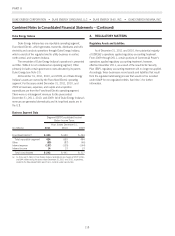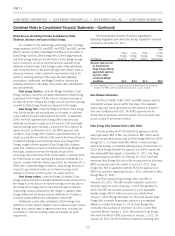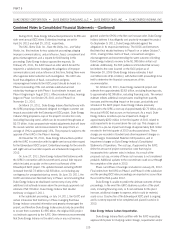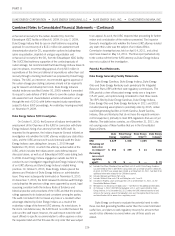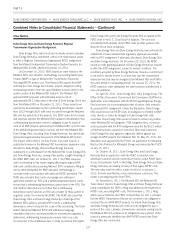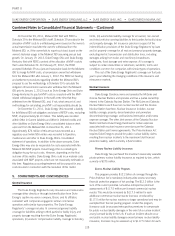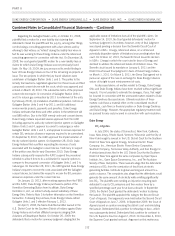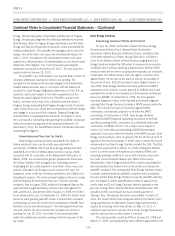Duke Energy 2011 Annual Report Download - page 148
Download and view the complete annual report
Please find page 148 of the 2011 Duke Energy annual report below. You can navigate through the pages in the report by either clicking on the pages listed below, or by using the keyword search tool below to find specific information within the annual report.
PART II
DUKE ENERGY CORPORATION •DUKE ENERGY CAROLINAS, LLC •DUKE ENERGY OHIO, INC. •DUKE ENERGY INDIANA, INC.
Combined Notes to Consolidated Financial Statements – (Continued)
On December 29, 2011, Midwest ISO filed with FERC a
Schedule 39 to the Midwest ISO’s tariff. Schedule 39 provides for the
allocation of MVP costs to a withdrawing owner based on the owner’s
actual transmission load after the owner’s withdrawal from the
Midwest ISO, or, if the owner fails to report such load, based on the
owner’s historical usage in the Midwest ISO assuming annual load
growth. On January 19, 2012, Duke Energy Ohio and Duke Energy
Kentucky filed with FERC a protest of the allocation of MVP costs to
them under Schedule 39. On February 27, 2012, the FERC
accepted Schedule 39 as a just and reasonable basis for the Midwest
ISO to charge for MVP costs, a transmission owner that withdraws
from the Midwest ISO after January 1, 2012. The FERC set hearing
and settlement procedures regarding whether the Midwest ISO’s
proposal to use the methodology in Schedule 39 to calculate the
obligation of transmission owners who withdrew from the Midwest
ISO prior to January 1, 2012 (such as Duke Energy Ohio and Duke
Energy Kentucky) to pay for MVP costs is consistent with the MVP-
related withdrawal obligations in the tariff at the time that they
withdrew from the Midwest ISO, and, if not, what amount of, and
methodology for calculating, any MVP cost responsibility should be.
On December 31, 2011, Duke Energy Ohio recorded a liability
for its Midwest ISO exit obligation and share of MTEP costs, excluding
MVP, of approximately $110 million. This liability was recorded
within Other in Current liabilities and Other in Deferred credits and
other liabilities on Duke Energy Ohio’s consolidated balance sheet
upon exit from the Midwest ISO on December 31, 2011.
Approximately $74 million of this amount was recorded as a
regulatory asset while $36 million was recorded to Operation,
maintenance and other in Duke Energy Ohio’s consolidated
statement of operations. In addition to the above amounts, Duke
Energy Ohio may also be responsible for costs associated with the
Midwest ISO MVP projects. Duke Energy Ohio is contesting its
obligation to pay for such costs. However, depending on the final
outcome of this matter, Duke Energy Ohio could incur material costs
associated with MVP projects, which are not reasonably estimable at
this time. Regulatory accounting treatment will be pursued for any
costs incurred in connection with the resolution of this matter.
5. COMMITMENTS AND CONTINGENCIES
General Insurance
The Duke Energy Registrants carry insurance and reinsurance
coverage either directly or through indemnification from Duke
Energy’s captive insurance company, Bison, and its affiliates,
consistent with companies engaged in similar commercial
operationswithsimilartypeproperties.TheDukeEnergy
Registrants’ coverage includes (i) commercial general liability
coverage for liabilities arising to third parties for bodily injury and
property damage resulting from the Duke Energy Registrants’
operations; (ii) workers’ compensation liability coverage to statutory
limits; (iii) automobile liability coverage for all owned, non-owned
and hired vehicles covering liabilities to third parties for bodily injury
and property damage; (iv) insurance policies in support of the
indemnification provisions of the Duke Energy Registrants’ by-laws
and (v) property coverage for all real and personal property damage,
excluding electric transmission and distribution lines, including
damages arising from boiler and machinery breakdowns,
earthquake, flood damage and extra expense. All coverage is
subject to certain deductibles or retentions, sublimits, terms and
conditions common for companies with similar types of operations.
The cost of the Duke Energy Registrants’ coverage can fluctuate
year to year reflecting the changing conditions of the insurance and
reinsurance markets.
Nuclear Insurance
Duke Energy Carolinas owns and operates the McGuire and
Oconee Nuclear Stations and operates and has a partial ownership
interest in the Catawba Nuclear Station. The McGuire and Catawba
Nuclear Stations each have two nuclear reactors and the Oconee
Nuclear Station has three. Nuclear insurance includes: nuclear
liability coverage; property, decontamination and premature
decommissioning coverage; and business interruption and/or extra
expense coverage. The other joint owners of the Catawba Nuclear
Station reimburse Duke Energy Carolinas for certain expenses
associated with nuclear insurance premiums per the Catawba
Nuclear Station joint owner agreements. The Price-Anderson Act
requires Duke Energy to provide for public nuclear liability claims
resulting from nuclear incidents to the maximum total financial
protection liability, which currently is $12.6 billion.
Primary Nuclear Liability Insurance.
Duke Energy has purchased the maximum reasonably available
private primary nuclear liability insurance as required by law, which
currently is $375 million.
Excess Nuclear Liability Program.
This program provides $12.2 billion of coverage through the
Price-Anderson Act’s mandatory industry-wide excess secondary
financial protection program of risk pooling. The $12.2 billion is the
sum of the current potential cumulative retrospective premium
assessments of $117.5 million per licensed commercial nuclear
reactor. This would be increased by $117.5 million for each
additional commercial nuclear reactor licensed, or reduced by
$117.5 million for nuclear reactors no longer operational and may be
exempted from the risk pooling program. Under this program,
licensees could be assessed retrospective premiums to compensate
for public nuclear liability damages in the event of a nuclear incident
at any licensed facility in the U.S. If such an incident should occur
and public nuclear liability damages exceed primary nuclear liability
insurance, licensees may be assessed up to $117.5 million for each
128


